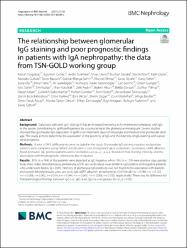The relationship between glomerular IgG staining and poor prognostic findings in patients with IgA nephropathy: the data from TSN-GOLD working group

View/
Access
info:eu-repo/semantics/openAccessDate
28.10.2021Author
Turgutalp, KenanCebeci, Egemen
Türkmen, Aydın
Derici, Ülver
Seyahi, Nurhan
Eren, Necmi
Dede, Fatih
Güllülü, Mustafa
Baştürk, Taner
Manga Şahin, Gülizar
Yılmaz, Mürvet
Sipahi, Savaş
Şahin, Garip
Ulu, Sena
Tatar, Erhan
Gündoğdu, Ali
Turan Kazancıoğlu, Rümeyza
Sevinç, Can
Güngör, Özkan
Şahin, İdris
Kutlay, Sim
Kurultak, İlhan
Aydın, Zeki
Altun, Bülent
Dursun, Belda
Yılmaz, Zülfikar
Uzun, Özcan
Süleymanlar, Gültekin
Candan, Ferhan
Sezer, Siren
Başak Tanburoğlu, Derya
Biçik Bahçebaşı, Zerrin
Taymez, Dilek
Akçalı, Esra
Oygar, Deren
İstemihan, Zülal
Bardak, Simge
Akçay, Ömer Faruk
Dinçer, Mevlüt Tamer
Dervişoğlu, Erkan
Yenigün, Ezgi
Türkmen, Kültigin
Öztürk, Savaş
Metadata
Show full item recordCitation
Turgutalp, K., Cebeci, E., Turkmen, A., Derici, U., Seyahi, N., Eren, N., ... & Ozturk, S. (2021). The relationship between glomerular IgG staining and poor prognostic findings in patients with IgA nephropathy: the data from TSN-GOLD working group. BMC nephrology, 22(1), 1-8.Abstract
Background
Galactose-deficient IgA1 (Gd-IgA1) has an increased tendency to form immunocomplexes with IgG in the serum, contributing to IgAN pathogenesis by accumulating in the glomerular mesangium. Several studies showed that glomerular IgG deposition in IgAN is an important cause of mesangial proliferation and glomerular damage. This study aims to determine the association of the positivity of IgG and the intensity of IgG staining with a poor renal prognosis.
Methods
A total of 943 IgAN patients were included in the study. Glomerular IgG staining negative and positive patients were compared using Oxford classification scores, histopathological evaluations, proteinuria, eGFR, albumin, blood pressures. IgG positive patients were classified as (+), (++), (+++) based on their staining intensity, and the association with the prognostic criteria was also evaluated.
Results
81% (n = 764) of the patients were detected as IgG negative, while 19% (n = 179) were positive. Age, gender, body mass index, blood pressure, proteinuria, eGFR, uric acid values were similar in IgG positive and negative patients who underwent biopsy (p > 0.05). Intensity of glomerular IgG positivity was not found to be associated with diastolic and systolic blood pressure, urea, uric acid, age, eGFR, albumin, proteinuria (p > 0.05 for all, r = − 0.084, r = − 0.102, r = − 0.006, r = 0.062, r = 0.014, r = − 0.044, r = − 0.061, r = − 0.066, r = 0.150, respectively). There was no difference for histopathological findings between IgG (+), IgG (++), IgG (+++) groups (for all, p > 0.05).
Conclusion
Glomerular IgG negativity and positivity detected by routine IFM in IgAN patients is not associated with poor renal prognostic risk factors.















